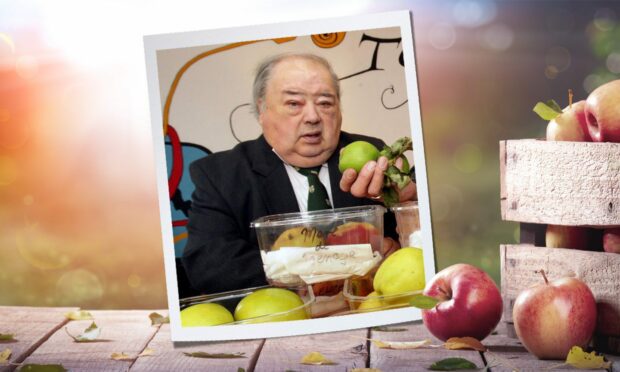Willie Duncan, one of the most notable custodians of Scotland’s horticultural heritage, has died aged 87.
He was informally known as the Apple King because of his expertise in his subject, gathered over a life in horticulture.
Willie, often described as a green-fingered magician, had an encyclopaedic knowledge of the hundreds of varieties once common in Scotland.
His interest in the fruit began while he was working at the then Scottish Crop Research Institute at Invergowrie.
Creation
In later life, Willie would create his own garden at Drumeldrie near the Fife coast with an orchard containing more than 80 varieties of apples.
Willie also had a national profile. He was an accomplished broadcaster who often gave gardening advice on Radio Scotland.
He was a member of the National Trust for Scotland committee in charge of more than 40 gardens and, in the 1980s, championed the development of Silverburn Park in Leven.
Willie and his long-term partner, Barbara, opened up his garden at Drumeldrie under Scotland’s Gardens Scheme and passed donations to charities.
Interests
Over a 22-year period, he was chairman of Largo and Newburn Horticultural Society, a pony breeder and an aficionado of traditional fiddle music.
In 2014, Willie’s services to horticulture were recognised when he was made an MBE and received his honour from the Queen at Holyrood Palace.
Willie was also an expert guest at outdoor events and garden centres across the country and a judge at flower shows.
He was born to Jim and Barbara Duncan in July, 1935 at Cock-ma-Lane Cottage on the Durie Estate, Leven, where his family has connections with the Christie family stretching back four generations.
Career begins
Willie had three brothers, Wallace, Jim and Andy, and when he left school in 1950 he began working with his father in the gardens on the estate, progressing to an apprenticeship with Leven Town Council which he completed in 1954.
He then did his National Service with the RAF mountain rescue team before joining Craigtoun Park, St Andrews, as a gardener before moving to Glenrothes Corporation in 1957.
A year later he began work at the Scottish Crop Research Institute near Invergowrie and it was there he pivoted towards specialising in apples.
He spent his lunch hours visiting the institute’s museum collection and soon became acquainted with the characteristics of hundreds of varieties.
Expertise
Willie also got to know the staff member responsible for grafting and was soon able to take twigs from one tree and attach them to another tree so they would bear fruit.
From Invergowrie he moved to work with Lord Fraser of Allander on the development of Aviemore as a resort. He also had a spell working with James Laurie and Sons at Ninewells, Dundee.
In 1965 he was invited back to Leven Town Council, became area superintendent for Kirkcaldy Town Council, then district council, and took early retirement in 1991.
Success
Under his supervision, Leven won Britain in Bloom in 1978 and Willie became a much sought-after speaker and horticultural lecturer.
When Willie and Barbara took over Strathmore Cottage, Drumeldrie, in 1975 it was little more than a field but the couple gathered the fruits of Scotland and the flowers of the world to create their own paradise.
Willie viewed many of the varieties in his orchard as collectors items, retained for their historic value rather than eating qualities.
Among the varieties he preserved was the Arbroath Oslin, said to have been grown by the monks at Arbroath Abbey, the Lass o’ Gowrie and the Bloody Ploughman.

Conversation